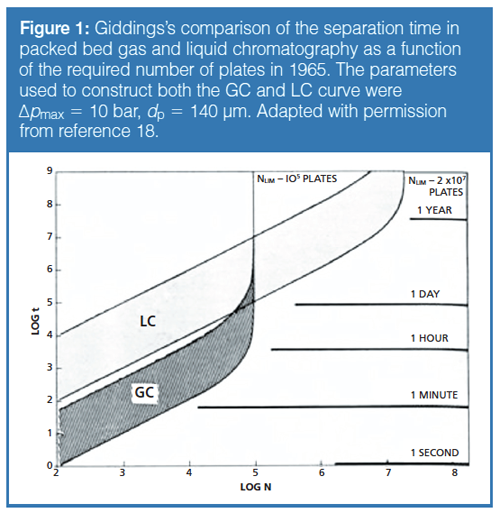New Sample Preparation Products and Accessories for 2017
LCGC Europe
This yearly report on new products introduced at Pittcon 2017 (or in the preceding year) covers sample preparation instrumentation, supplies, and accessories.
Douglas E. Raynie, Sample Prep Perspectives Editor
This yearly report on new products introduced at Pittcon 2017 (or in the preceding year) covers sample preparation instrumentation, supplies, and accessories.
The classic British rock band The Who once famously sang, “Meet the new boss, same as the old boss”. This lyric sums the new sample preparation products introduced to the market in the past year. Although there were no earth-shattering new product breakthroughs, seemingly mature techniques found a renewed resurgence of interest. This was especially true for headspace sampling and sorbent technology.
Our annual review of sample preparation products covers the previous year (from April 2016 on). The primary focus is new product introductions at Pittcon, though this is not the exclusive focus. In late 2016, the LCGC editorial staff submitted a survey to vendors of sample preparation products. Responses to this survey are compiled in this review. Additionally, a keyword search using the terms “sample preparation” and “extraction” was conducted for exhibitors at Pittcon 2017; then each of these vendors was visited. While attempts were made to be as inclusive as possible, we apologize for any oversight.
This review is presented in three sections. First, we discuss advances in headspace analysis, an established technique for which innovative approaches were developed. Next new solidâphase sorbents and sorbent-based products are presented. Sorbent technologies are seeing increased development for both general and selective purposes. Finally, we turn to other sample preparation instrumentation, accessories, and supporting technologies. To assist readers with some of the details behind these new products, each section presents a tabular summary of the associated products.
Headspace Analysis
Procuring gaseous samples from the headspace above a product before gas chromatographic analysis, while not without its challenges, is generally considered a somewhat mature technology. Thus, it was somewhat surprising that the major new product introductions in sample preparation centred on this technique. Most notably, Entech presented what they term “Vacuum Assisted Sorbent Extraction (VASE)”. The heart of the VASE system is the Sorbent Pen device (shown in Figure 1), which combines features of solid-phase microextraction (SPME) with conventional adsorbent traps in a flexible design. Among the features of the Sorbent Pen is an outer sheath that minimizes sorbent exposure to artifacts like aerosols created during sample agitation. When combined with an applied vacuum in the VASE system, the vendor claims applicability to a wider range of analyte volatilities than competitive products, especially at the high volatility end. With the vacuum application option, the Sorbent Pen can be used in both static extractions for aroma determination and dynamic extractions for compositional analysis. For largeâvolume static headspace extractions, Entech introduced the model 7650HS-CTS system. The highlight of this system is direct capillary column trapping. This trapping, combined with sample heating up to 100 °C, allows quantitative isolation of compounds with a boiling range of -50 °C to greater than 400 °C.
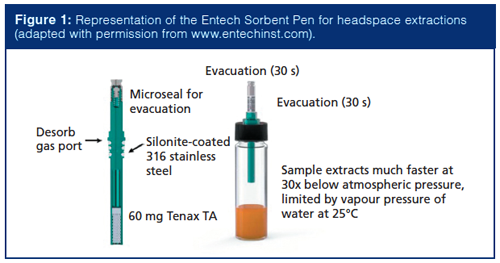
PAL (CTC Analytics) developed the patent pending “SPME Arrow” as its entry into the SPME market. The SPME Arrow is differentiated from conventional SPME fibres by a metal core that is larger (1.1 or 1.5 mm diameter) with a pointed (arrowâshaped) tip and significantly higher sorptive-phase volume and surface area. As a result, the SPME Arrow has a higher sample throughput, greater sensitivity, a wider linear range, and a greater lifetime. Figure 2 demonstrates the theoretically extended range of the SPME Arrow compared to conventional SPME and stir-bar sorptive extraction (SBSE) as a function of analyte polarity. The larger phase volume of the SPME Arrow leads to an approximately 1.5 order of magnitude increase in extracted analyte polarity compared to the conventional format, but less than the even larger sorbent volume of SBSE. SPME is often used in headspace analyses and the SPME Arrow complements PAL’s ITEX dynamic headspace system. This unit utilizes an in-tube extraction approach to achieve sensitivities similar to purgeâandâtrap analysis. Liquid–liquid extraction, solidâphase extraction (SPE), SPME, agitation, and other modes are available. CDS Analytical introduced a purgeâandâtrap concentrator compatible with the PAL autosamplers. Among other features, the concentrator accurately adds internal reference standards to the sample.
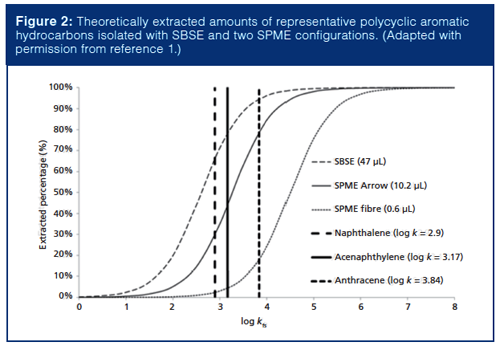
Related to headspace analysis, CDS Analytical also presented upgrades to its 6200 Pyroprobe pyrolysis system featuring easier sample loading (from a vertical position) and a more straightforward user interface. Gerstel introduced the TDU 2 thermal extraction system, a fourth generation of their thermal desorption product with a short sample path and flexible sample introduction capability for gas chromatography–mass spectrometry (GC–MS). Thermal desorption may occur from a sorbent tube, SBSE, SPME, or directly from the sample. Meanwhile, Gerstel accommodates emissions testing with the DHSL automated microscale chamber, also new this year.
Solid-Phase Sorbents
One of the modern trends in the field of extraction is the use of solidâphase sorbents in techniques like SPE, SPME, SBSE, and others. While products and accessories specifically for these sorbent-based extractions are discussed in the following section, here we look specifically at new (bulk) sorbent phases. These are summarized in Table 1.
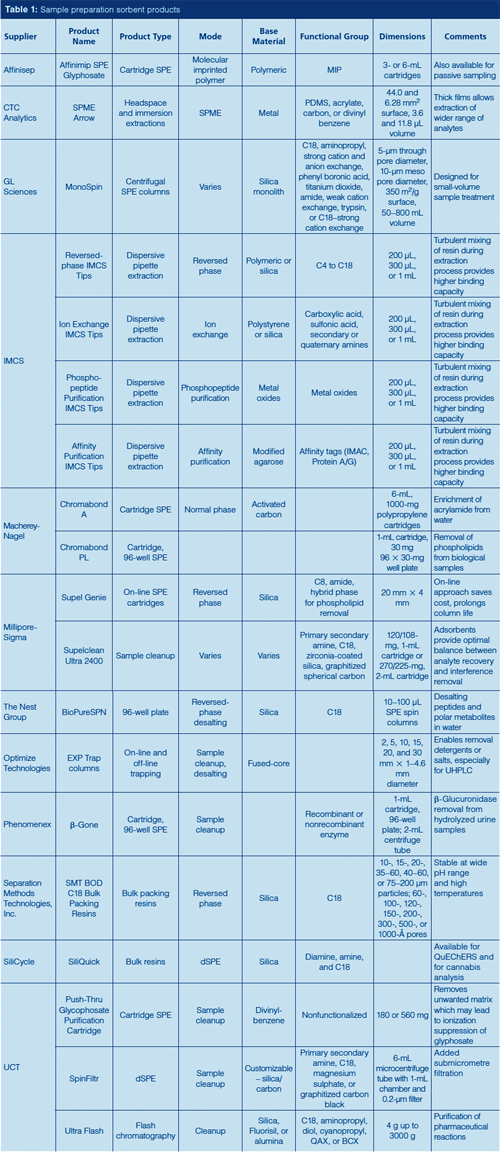
Separation Methods Technologies (SMT) introduced two silica-based phases with particle diameters ranging from 10 to 200 µm and with porosities ranging from 60 to 1000 Å. One of these phases was the oft-used C18, but SMT’s proprietary bonding scheme allows separations under aggressive pH schemes so that acid or base hydrolysis is minimized. For example, most basic solutes can be separated without the use of trifluoroacetic acid. A strong cation exchange resin is stable at high flow rates and high pressures, and does not swell with organic solvents. GL Sciences uses highly purified silica in a monolithic format in its Monospin SPE product. A wide range of phases including standard SPE phases, titanium dioxide, trypsin, and phenyl boronic acid is available.
The QuEChERS (quick, easy, cheap, effective, rugged, and safe) method for the isolation of pesticides from produce has expanded to myriad analyte and matrix combinations. Hence, a continued development of sorbents for the dispersive-SPE portion of the technique is observed. SiliCycle devised the SiliQuick product line for QuEChERS applications. A silicaâbased diamine acts similarly to primary secondary amine products, and it is complemented with an amine product that not only removes sugars and fatty acids, but is less likely to catalyze the degradation of base-sensitive analytes. Both work in combination with a C18 product. United Chemical Technologies (UCT) combines dispersive-SPE with ultracentrifugation by placing the sorbent media with the centrifuge tube. The SpinFiltr sorbent-containing centrifuge tube is customizable with primary secondary amine, C18, magnesium sulphate, and graphitized carbon on silica or carbon support material. Supelclean Ultra cartridges from MilliporeSigma have a high capacity for matrix removal and are especially attractive for dry or difficult samples.
Specialty phases are becoming increasingly prevalent. For example, Affinisep developed a molecularly imprinted polymer (MIP), Affinimip SPE Glyphosate, designed for the broad-spectrum herbicide glyphosate and its primary breakdown product. One configuration of the MIP product allows for passive sampling of aqueous sources. UCT uses a nonfunctionalized divinylbenzene for the cleanup of sample matrices during glyphosate analysis. The company’s product is embodied in a push-through cartridge format. During drug metabolism, the parent compound is typically conjugated with glucuronic acid to adjust its polarity. As an alternative to the classic dilute-and-shoot liquid chromatography–mass spectrometry (LC–MS) analysis, Phenomenex developed the β-Gone β-glucuronidase removal products in both cartridge and 96-well plate formats. Sensitivity enhancements of 10–30×, similar to the sample dilution factor in the conventional method, was shown in one application note for urinary samples (2). Macherey-Nagel introduced two new sorbents under its Chromabond line. Chromabond Carbon A is a high-surface-area activated carbon designed for the enrichment of acrylamide from water, while Chromabond PL is specific for the removal of phospholipids via an internal protein precipitation. Also in the pharmaceutical development arena, UCT’s Ultra Flash purification products can be tailored to the end user with C18, aminopropyl, diol, cyanopropyl, or ion-exchange functional groups on silica, fluorosil, or alumina at scales from 4 to 3000 g. The BioPureSPN SPE spin cartridge was developed for the desalting of peptides using C18 media from The Nest Group.
Sorbent Products
Dispersive Pipette Extraction: Dispersive pipette extraction aims to provide rapid extraction with minimal solvent use by loosely packing the bulk sorbent phase in a pipette tip. Sample and extraction phases can be drawn through the pipette tip and the method may be easily automated. IMCS (Integrated MicroâChromatography Systems) developed dispersive pipette extraction products with four different phases. Weak or strong anion or cation exchangers can be placed on polystyrene or silica and the available tips work with liquid handling systems from a number of vendors. Similarly, reversed-phase sorbents from C4 to C18, metal oxides for phosphopeptide enrichment, and affinity tags placed onto agarose are available.
Accessories and Other Sorbent Extraction Products: In the attempt to further streamline the analytical flow, MilliporeSigma configured SPE in an on-line cartridge format, Supel Genie. Standard reversed phases and hybrid phases for phospholipid removal are available. Salts and detergents, especially found in biological samples, may suppress the ionization of analytes in MS. Optimize Technologies developed EXP Trap columns, in both off- and on-line modes, to remove these MS interferences and increase MS sensitivity. A variety of column and packing dimensions are available. With the widespread use of SPE in the 96-well plate format, accessories to ease sample handling are also becoming available. Analytical Sales and Services markets both a lightweight aluminium cover to alphanumerically identify each well, and the SpeedyBead, which drops an agitation bead into each well. The DEXTech Plus automated sample preparation system from LCTech uses acidic silica, aluminium oxide, or florisil, and carbon columns for the isolation of polychlorinated biphenyls and dioxins according to the United States Environmental Protection Agency (EPA) and European protocols. Column-based sample preparation techniques, including SPE, protein precipitation, and supported-liquid extraction, rely on mobile (extracting) phases being passed through the column via pressure or vacuum. Problems with channeling or uneven flow across manifolds or 96-well plates can occur. Phenomenex addresses these concerns with the Presston 100 positive pressure manifold. The system relies on applied gas pressure and can easily be converted between 1-, 3-, and 6-mL tubes and 96-well plates.
Sample Preparation Instrumentation, Accessories, and Related Products
Sample preparation instrumentation and other products, including those previously discussed, are summarized in Tables 2 and 3.
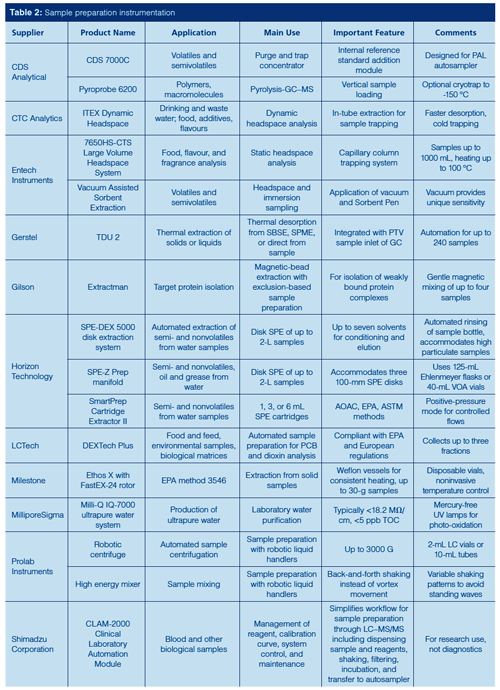
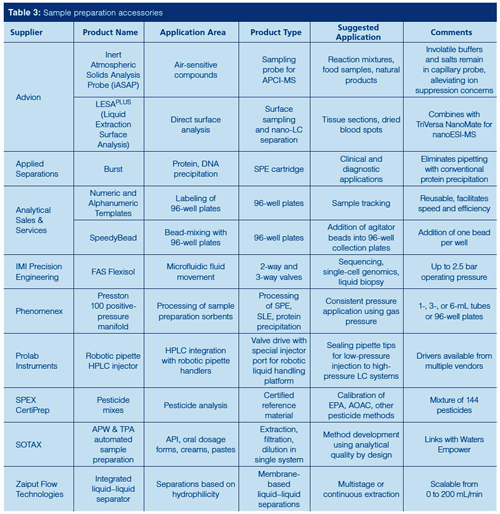
Sample Preparation Instrumentation: Sotax introduced its fourth generation APW and TPW automated sample preparation systems. The systems alleviate repetitive processes like weighing, liquid transfer, sonication, and documentation. The fourth-generation systems link to the Waters Empower data system. Horizon Technology presented a family of instruments for cartridge and disk approaches to SPE of water samples. The SPEâDEX 5000 disk extraction system allows the automated extraction of semiâ and nonvolatile analytes from water samples by including all steps of the SPE-disk method. Meanwhile, the company’s SPE-Z Manifold is a step between manual extractions to transitioning to automation in the laboratory. Both semi- and nonvolatile samples, as well as oil and grease, with volumes up to 2 L are accommodated. Then the automated water extractions can be performed with the SmartPrep Cartridge Extractor II system. Each of the steps required in blood analysis by LC–MS, including dispensing, stirring, filtering, and sample transfer, is accomplished with Shimadzu’s CLAMâ2000 Clinical Laboratory Automation Module. The CLAM-2000 results in a more efficient laboratory workflow. Robotic simplification of repeated tasks is the aim of Prolab Instruments, which developed a series of instruments for centrifugation, LC injection, and high-energy mixing. A continuousâflow membrane separator is the heart of the Zaiput integrated liquid–liquid separator. The membrane separation can then be developed for continuous liquid–liquid extraction, process monitoring, or continuous product isolation after chromatography. The EST Flex XTR autosampler platform has been available for some time, but the company is now emphasizing customizable applications. Gilson has continued development of the Extractman magnetic bead extraction platform. The magnetic bead technology combines with exclusionâbased technology for the isolation of weakly bound protein complexes.
Although most of this product review focuses on headspace or liquid samples and sorbent-phase extractions, analyte isolation from solid samples also remains a top analytical challenge. Milestone updated its Ethos X microwave extraction system with its FastEX-24 rotor. The system allows US EPA 3546 sample extraction using disposable vials. Especially given the analytical power of modern MS and related techniques, direct analysis is desirable in many laboratories. Advion takes a big step in that direction with the LESAPLUS or Liquid Extraction Surface Analysis Plus LC separation system. The system features a chipâbased electrospray ionization coupled with nano-LC and MS. Meanwhile the Advion iASAP inert atmospheric solids analysis probe claims to eliminate the need for sample preparation and chromatography for sampling and MS characterization of air-sensitive compounds.
Accessories: Micromedia separations using microfluid liquid and gaseous flows require precise valves and the IMI Precision Engineering FAS Flexisol series of valves were introduced for this purpose. The Burst cartridge (Applied Separations) combines features of SPE and centrifugation in a simple, disposable product for protein and DNA precipitation. Sample and reagent are added to the Burst cartridge, and after mixing, the device filter is disrupted and liquid is collected into a centrifugation tube. Of course, sample analysis requires standards and reference materials for method development and quantification. QuEChERS and related methods are placing a renewed interest on pesticide-residue testing, and SPEX answered the call with the introduction of a certified reference material premixed with 144 pesticides. Similarly, ultrapure water is key in many analyses and MilliporeSigma continued its leadership in this field with the seventh generation Milli-Q IQ-7000 system. Not only is this ultrapure water system more compact, but the necessary purity for ultrahighâpressure liquid chromatography (UHPLC)–MS and other sensitive analyses results.
Conclusion and Future Directions
New sample preparation products in the past year seem to have focused on headspace analysis, protein precipitation, and bioanalysis as well as the refinement and development of sorptive phases. Whether this trend continues or expands into consideration of food, environmental, and related analysis is the question for the coming year.
References
- A. Kremser, M.A. Jochmann, and T.C. Schmidt, Anal. Bioanal. Chem.408, 943–952, doi:10.1007/s00216-015-9187-z. (http://creativecommons.org/licenses/by/4.0/) (2016).
- M. Brusius and J. Cybulski, “Improved Sensitivity of Hydrolyzed Urine Samples Using β-Gone™ β-Glucuronidase Removal Products,” Phenomenex application note TN-101 (2016).
“Sample Preparation Perspectives” editor Douglas E. Raynie is an associate research professor at South Dakota State University, USA. His research interests include green chemistry, alternative solvents, sample preparation, high resolution chromatography, and bioprocessing in supercritical fluids. He earned his Ph.D. in 1990 at Brigham Young University under the direction of Milton L. Lee.

New TRC Facility Accelerates Innovation and Delivery
April 25th 2025We’ve expanded our capabilities with a state-of-the-art, 200,000 sq ft TRC facility in Toronto, completed in 2024 and staffed by over 100 PhD- and MSc-level scientists. This investment enables the development of more innovative compounds, a broader catalogue and custom offering, and streamlined operations for faster delivery. • Our extensive range of over 100,000 high-quality research chemicals—including APIs, metabolites, and impurities in both native and stable isotope-labelled forms—provides essential tools for uncovering molecular disease mechanisms and exploring new opportunities for therapeutic intervention.
New Guide: Characterising Impurity Standards – What Defines “Good Enough?”
April 25th 2025Impurity reference standards (IRSs) are essential for accurately identifying and quantifying impurities in pharmaceutical development and manufacturing. Yet, with limited regulatory guidance on how much characterisation is truly required for different applications, selecting the right standard can be challenging. To help, LGC has developed a new interactive multimedia guide, packed with expert insights to support your decision-making and give you greater confidence when choosing the right IRS for your specific needs.

.png&w=3840&q=75)

.png&w=3840&q=75)



.png&w=3840&q=75)



.png&w=3840&q=75)
